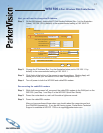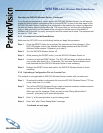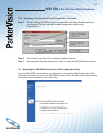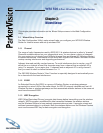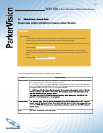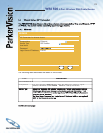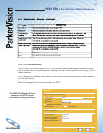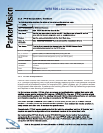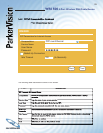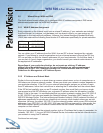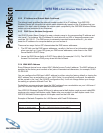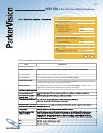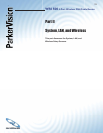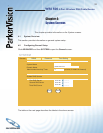
WR1500 4-Port Wireless DSL/Cable Router
®
25
3.4.2 PPTP Encapsulation - Continued
The following table describes the labels in the screen on the previous page.
LABEL
DESCRIPTION
DESCRIPTION
ISP Parameters for Internet Access
ISP Parameters for Internet Access
ISP Parameters for Internet Access
ISP Parameters for Internet Access
Encapsulation
Select
PPTP
from the drop-down list box.
User Name
Type the user name given to you by your ISP. Most home user will need to use their
Type the user name given to you by your ISP. Most home user will need to use their
name with their domain designation, such as user@bellsouth.net
Password
Type the password associated with the User Name above.
Nailed Up
Connection
Select
Select
Nailed Up Connection
Nailed Up Connection
if you do not want the connection to time out.
if you do not want the connection to time out.
Idle Timeout
Type the time in seconds that elapses before the WR1500 Wireless Router
Type the time in seconds that elapses before the WR1500 Wireless Router
automatically disconnects from the PPTP server.
PPTP Confi guration
PPTP Confi guration
PPTP Confi guration
PPTP Confi guration
My IP Address
Type the (static) IP address assigned to you by your ISP.
Type the (static) IP address assigned to you by your ISP.
My IP Subnet
My IP Subnet
Mask
Type the subnet mask assigned to you by your ISP (if given).
Type the subnet mask assigned to you by your ISP (if given).
Server IP Address
Server IP Address
Type the IP address of the PPTP server.
Type the IP address of the PPTP server.
Connection
Connection
ID/Name
If your ISP has provided a connection ID name, enter it in this fi eld exactly as
If your ISP has provided a connection ID name, enter it in this fi eld exactly as
provided.
Next
Click
Click
Next
to continue.
Back
Click
Click
Back
to return to the previous screen.
3.4.3 PPPoE Encapsulation
Point-to-Point Protocol over Ethernet (PPPoE) functions as a dial-up connection. PPPoE is an
IETF (Internet Engineering Task Force) draft standard specifying how a host personal computer
interacts with a broadband modem (for example xDSL, cable, wireless, etc.) to achieve access
to high-speed data networks. It preserves the existing Microsoft Dial-Up Networking experience
and requires no new learning or procedures.
For the service provider, PPPoE offers an access and authentication method that works with
existing access control systems (for instance, RADIUS). For the user, PPPoE provides a login
and authentication method that the existing Microsoft Dial-Up Networking software can activate,
and therefore requires no new learning or procedures for Windows users.
One of the benefi ts of PPPoE is the ability to let end users access one of multiple network
services, a function known as dynamic service selection. This enables the service provider to
easily create and offer new IP services for specifi c users.
Operationally, PPPoE saves signifi cant effort for both the subscriber and the ISP/carrier, as it
requires no specifi c confi guration of the broadband modem at the subscriber’s site.
By implementing PPPoE directly on the WR1500 Wireless Router (rather than individual
computers), the computers on the LAN do not need PPPoE software installed, since the
WR1500 Wireless Router does that part of the task. Furthermore, with NAT, all of the LAN’s
WR1500 Wireless Router does that part of the task. Furthermore, with NAT, all of the LAN’s
computers will have Internet access.
computers will have Internet access.
Refer to the appendix for more information on PPPoE, and to the next page for setup details.



